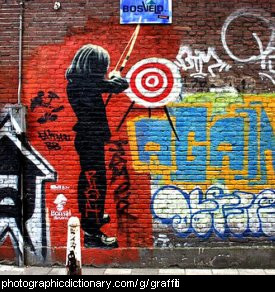Gis forGovernment
Graffiti is writing or drawing somewhere you are not allowed to write or draw. You usually find graffiti in train stations or anywhere there is a big empty wall.
Some graffiti is just messy vandalism, but some can be very artistic. Graffiti is against the law in most countries and in some places you can go to prison if you are caught graffiting.
Grafting is a process of making a piece of a plant grow by attaching it to another plant. This process is often used to attach a tree that is a good bearer of fruit to another that has strong roots, combining the best qualities of two plants. It can also be used to have different but related kinds of fruit growing on the same tree.
The graft in the picture has been made by cutting a slit into the stem of the host tree and putting a stem from another tree into the slit.
Gis forGrain (cereal)
Gis forGrain (texture)
Grain is a word used to describe the direction of the fibers or layers inside a natural material like wood or stone. Materials with a grain are very easy to split along the direction of the grain, and they are naturally stronger if the grain is run lengthways along a piece of that material.
Anything else that has a distinct direction in what it is made from can also be described as having a grain, such as the direction of fur on an animal's hide.
A gram is a small unit of weight. There are 1000 grams in a kilogram. The picture is of forty-three grams of jigsaw puzzle pieces. One puzzle piece would weigh about one gram.
Gis forGramophone
A gramophone, or phonograph, is a device that was used for playing recorded sound from the 1870s through the 1980s. More recently, gramophones were called record players or turntables. Gramophones play records, large round, black platters.
The original gramophone did not need electricity to run, with the record being turned by winding it up, and the sound was amplified simply by the shape of the "horn" you can see in the picture at the top of the gramophone. The sound itself comes from the vibrations of a small needle, called a stylus, in a spiral groove on the surface of the record.





















